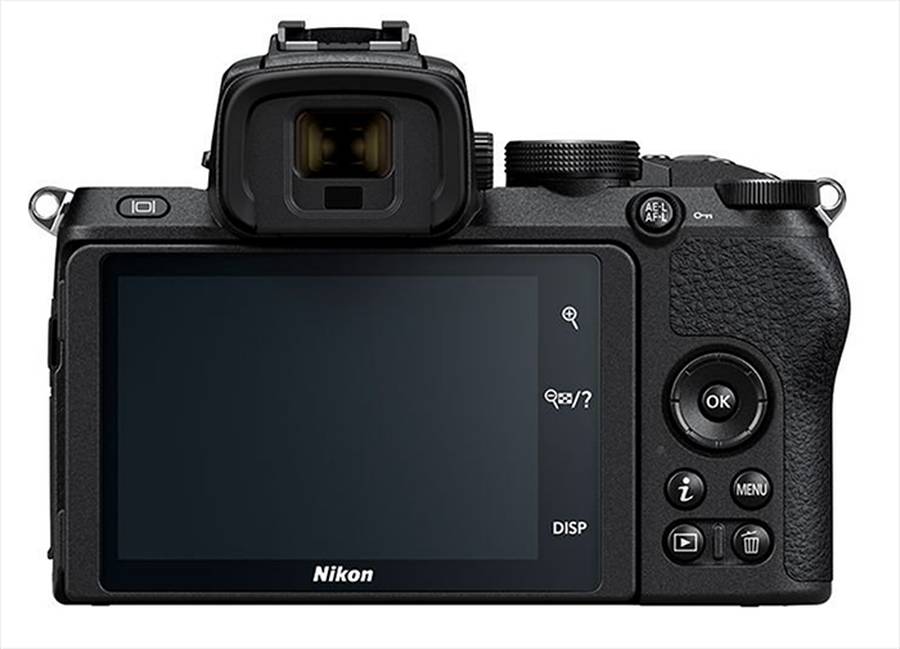

There's no button in the middle of the dial which must be pressed before you can rotate the dial, as on the Z6/Z7, although in practice the dial proved to be stiff enough to prevent accidental mode changes when the camera is stored in a bag. There’s space for two different groups of custom settings marked U1 and U2, which is very handy if you often find yourself shooting in a specific kind of situation, such as low light. From here, you can switch between the different shooting modes that the Z50 offers, including M/A/S/P as well as fully automatic. Moving to the top of the Z50, you’ll find another familiarity in the shape of the mode dial. A lens release button is found on the right of the mount. To the left of the lens mount are two customisable function buttons which are useful for assigning oft-used settings to. If you’re coming to the Z50 from a Nikon DSLR or the Z6/7, you’ll be very familiar with lots of the buttons here already, such as AE-L/AF-L, the Info button for accessing a quick men, and the switch on top for flicking between shooting video and shooting stills. It’s also not possible to use the touch-sensitive screen to set the AF point when shooting through the viewfinder, as on some rival models (although not the Z6/7), all of which makes selecting the AF point less intuitive than it could be. Instead you have to use the slower, less precise method of pressing the four directions on the rear d-pad to move the AF point, with a press of the OK button recentering it. Sadly, unlike on the Z6/Z7, there's no joystick which you can use to move focus points around the frame. While the Z50 doesn't have the same level of weatherproofing as the Z6/7, overall the build quality feels high enough to withstand a little bit of rough and tumble, as well as coping with a variety of different weather conditions, if you take the necessary precautions.Ĭontrol wise, almost all of the Z50’s buttons are grouped on the right hand side of the camera, making one handed operation easy. The lovely handgrip is still deep and chunky, while the rubberized covering across the whole camera body adds a tactile quality that belies the Z50's mid-range price-point, as does the magnesium alloy build. It weighs in at a mere 395g body only and measures 126.5 x 93.5 x 60mm, making this a camera that you can truly carry anywhere and at all times without really noticing it.ĭespite this drastic size reduction, it doesn’t go so far that the camera becomes unusable. Trying very hard not to alienate their existing customer base of DSLR users, the Z50 resembles a Z6/7 that's spent even longer time getting shrunk in the wash.
#NIKON Z50 FULL FRAME UPGRADE#
Nikon are hoping to tempt people to upgrade from their smartphones or their D7000-series Nikon DSLR with the Z50, as well as being an ideal backup camera for Z6 and Z7 owners.įor the design of the Z50, Nikon has taken things a step further than they did for the Z6/7 cameras, and miniaturized their DSLR camera blueprint even more. In terms of how Nikon sees the Z50, it sits alongside the D7500 and D500 DSLR cameras in their positioning. Three of them are mirrorless models, with the Z50 joining the Z6 and Z7 full-frame cameras. The introduction of the new Z50 means that there are now five full-frame and five APS-C cameras in Nikon's camera range. Various kits with the two new DX Z-mount lenses are also available. The Nikon Z 50 is available now priced at £849 / $856.95 body only.
#NIKON Z50 FULL FRAME ISO#
Other key features offered by the Nikon Z50 include a 20.9 megapixel APS-C sensor with 209 phase detection AF pixels, ISO range of 100-51200 that' expandable to 20400, 11fps burst shooting with AF/AE tracking, EXPEED 6 processor, 180-degree flip touch-screen, 2360k-dot EVF, 4K UHD video recording at 30p, Snapbridge, Wi-Fi and Bluetooth connectivity and a body that weighs less than 400g. In addition to the FX and new DX Z-mount lenses, the existing FTZ Mount Adapter that was released with the Z6/7 is also compatible with the Z50, which means that F-mount lenses can also be used with the new camera. The Z50 uses the same Z lens mount as the larger sensor cameras, which means that it can utilise the same range of Z branded FX lenses, albeit with a 1.5x crop factor applied.Īlongside the Z50, Nikon have also launched the first two lenses in a fledgling range of DX Z-mount lenses, a 16-50mm pancake zoom and 50-250mm super-telephoto zoom.

Following the launch of their full-frame models, the Z7 and Z6, the new Z50 is Nikon's first mirrorless camera with an APS-C sensor.


 0 kommentar(er)
0 kommentar(er)
